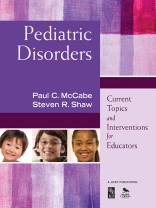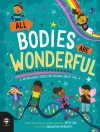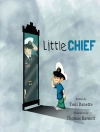‘The accessible format delivers a concise overview and research summary of each topic, followed by specific examples and practical educational strategies.’
—Katy Olweiler, Counselor
Lakeside School, Seattle, WA
‘Outstanding on multiple levels. It is a quick read for busy pre-practitioners and practitioners who are increasingly in need of accurate and current information regarding children′s health issues. The book also presents thought-provoking questions for professional growth or group discussions. The handouts afford the reader a unique mechanism for sharing the book′s contents with parents and colleagues.’
—Doris Paez, Associate Director, Forsyth Futures
Consulting Psychologist, Winston-Salem Forsyth County Public Schools, NC
The educator′s go-to reference for important pediatric health topics!
Medical issues in schools are a growing reality. In addition to teaching academic skills, educators now play an integral part in comprehensive health care delivery for children. Based on current research, this volume outlines the most current and urgent pediatric issues affecting schools today.
Written for school psychologists, counselors, administrators, and teachers, this easy-to-understand resource covers:
- Schools as partners in health care delivery, including health care delivery trends and collaborations between educators and medical professionals
- Current issues in pediatric disorders and treatments, such as childhood immunizations, shaken baby syndrome, sleep problems, and pediatric HIV
- Prevention and wellness intervention for childhood obesity prevention, low-level aggression in the schools, and accident prevention
Featuring case studies, classroom strategies, discussion questions, glossaries, and handouts, Pediatric Disorders provides valuable information to practitioners involved in providing differentiated instruction and educational accommodations, collaborating with families, working with the community, and influencing policy.
Зміст
Preface
Acknowledgments
I. Introduction: Schools as Partners in Health Care Delivery
1. Trends in Health Care Delivery: The Increased Burden on Schools as Health Care Providers – Paul C. Mc Cabe, Steven R. Shaw
Introduction
Pediatrics in the Schools
Role of Federal Legislation
Keeping Pace with the Trends in Health Care
Meeting the Additional Burden
References
2. Collaboration Between Educators and Medical Professionals: Models, Barriers and Implications – Sarah Glaser, Tia Ouimet, Steven R. Shaw
Introduction
Background
Why Collaboration between Educators and Medical Professionals is Necessary
Models of Collaboration
Independent functions model
Multidisciplinary team model
Interdisciplinary team model
Transdisciplinary team model
Obstacles and Barriers to Effective Collaboration
Dual systems
Interprofessional tensions
Financial and administrative issues
Legal issues
Credentialing
Ethical issues
Implications for Educators
Strategies for Effective Collaboration between Educators and Medical Professionals
Respecting professional boundaries
Encouraging active participation
Promoting frequent and clear communication
Fostering community relationships
Developing prevention and health promotion programs for students
Conclusions and Future Directions
Educational Strategies
Discussion Questions
Research Summary
Handout-Strategies for Effective Communication Between Educators and Medical Professionals
II. Current Issues in Pediatric Disorders and Treatments
3. Role of Otitis media in Hearing Loss and Language Deficits – Amy M. Racanello, Paul C. Mc Cabe
Introduction
Background
Disease Overview
Medical Treatment
Risk Factors for Developing Otitis Media
Age
Chronicity
Heritability
Chromosomal Disorders
Biofilms
Allergies
Otitis Media and Speech and Language Development
Implications for Educators
Student specific strategies
General classroom strategies
Educational Strategies
Discussion Questions
Research Summary
Handout-Otitis Media
4. Childhood Immunizations: The Power of Misinformation – Michelle Klein Brenner, Paul C. Mc Cabe
Introduction
Background
Development of Vaccinations
Opposition to Immunize
Fear of side effects
Fear of developing another disorder
Hemophilus influenza B (Hib) and diabetes
Pertussis and asthma
Measles, mumps, rubella (MMR) and autism
Implications for Educators
Educational Strategies
Discussion Questions
Research Summary
Handout-Childhood Immunizations: Know the Facts
5. Shaken Baby Syndrome: Immediate and Long Term Consequences and Implications for Educators – Tiffany Folmer Lawrence, Paul C. Mc Cabe
Introduction
Background
Prevalence and Risk Factors for Shaken Baby Syndrome
Clinical Presentation of SBS
Differential Diagnosis
Prevention and Intervention
Implications for Educators
Conclusion
Educational Strategies
Discussion Questions
Research Summary
Handout-Preventing Shaken Baby Syndrome
6. Assessment and Intervention for Sleep Problems – Joseph A. Buckhalt, Mona El-Sheikh
Introduction
Background
Diagnostic Considerations for Sleep Disorders
Sleep and health Correlates
Adolescent Sleep Patterns
Assessing Sleep Problems
Implications for Educators
Educational Strategies
Discussion Questions
Research Summary
Handout-Sleep Disorders
7. Cognitive Effects of Childhood Leukemia Treatments – Paul C. Mc Cabe
Introduction
Background
Definition of Leukemia
Etiology and Treatment
Learning Outcomes
Attention and Memory
Cognitive Abilities
Gender Effects
Limitations
Implications for Educators
Educational Strategies
Discussion Questions
Research Summary
Handout-Cognitive Effects of Leukemia Treatments
8. An Overview of Pediatric Human Immunodeficiency Virus (HIV) – Sarah A. B. Wilson, W. mark Posey, Emily E. Powell
Introduction
Background
Scope of the Problem
Motor Development and Visual-Motor Effects of HIV
Cognitive Effects
Language Development
Executive Functioning
Psychological Adjustment
Disclose
Implications for Educators
Educational Strategies
Discussion Questions
Research Summary
Handout-Pediatric HIV
9. Bacterial Meningitis – Paul C. Mc Cabe, Fallon Lattari
Introduction
Background
Pathogenesis
Clinical Symptoms
Neurological Effects
Diagnosis
Epidemiology, Immunization, and Treatment
Research Limitations
Prevention
Implications for Educators
Educational Strategies
Discussion Questions
Research Summary
Handout-Information about Bacterial Meningitis
10. Lyme Disease and Tick-Borne Infections: Etiology, Physical and Neuropsychological Sequelae in Children – Ronald A. Hamlen, Deborah S. Kliman
Introduction
Background
Infection Incidence and Risk
Diagnosis
Neurological and Cognitive Deficits
Developmental Delay, Attention and Austistic Spectrum Disorders
Depressive, Panic and Aggressive Disorders
Long-term Outcome
Implications for Educators
Educational Strategies
Discussion Questions
Research Summary
Handout-pediatric Lyme Disease and Associated Tick-Bourne Infections
III. Prevention and Wellness Intervention
11. Childhood Obesity Prevention: A Review for Educators – Jessica Blom-Hoffman, Laura Anderson
Introduction
Background
Child & Family Context
Biological Factors
Behavioral Factors
Socioeconomic and Cultural Factors at the Family Level
The Community
The School
Intra-School Processes
School Environment
Family, Community, & School: Healthy Weight Facilitated
Educational Strategies
Discussion Questions
Research Summary
Handout-Strategies to Help Children Achieve a Healthy Weight
12. Low Level Aggression in the School: Issues and Interventions – Rebecca Lakin Gullan, Julie Paquette Mac Evoy,
Introduction
Background
What is a Normal Level of Aggression?
Conflict versus Aggression
Cultural Differences
Classroom Differences
Defining Non-Physical Aggression
Bullies, Victims, and Aggressive-Victims
Bully-Victims
Aggression and Social Status: The Role of Perceived Popularity
Implications for Educators
Evaluation at the Child Level
Evaluating Context
Matching Intervantion to Child Contextual Characteristics
Prevention
Intervening with Victims
Intervening with Aggressors
Intervening with Bully-Victims
Changing Social Norms
Educational Strategies
Discussion Questions
Research Summary
Handout-Helping Children with Aggression
13. Accident Prevention – Marybeth Bailer-Heath, Sarah Valley-Gray
Introduction
Background
Motor Vehicle Safety
Pedestrian Safety
Bicycle Safety
Sports, Recreation, and Swim Safety
Sports and Recreation Safety
Swim Safety
Traumatic Brain Injury and Spinal Cord Injury
Implications for Educators
Educational Strategies
Discussion Questions
Research Summary
Handout-Tips to Prevent Childhood Accidental Injury
Appendix
Glossary
References
Index
Про автора
Steven R. Shaw, NCSP, is an assistant professor in the Department of Educational and Counselling Psychology at Mc Gill University in Montreal, Quebec. He has been a school psychologist since 1988 with clinical and administrative experience in schools, hospitals, and independent practice. He has conducted workshops and consulted with educational policy makers to address the needs of children with borderline intellectual functioning in the US, Canada, Pakistan, Moldova, Poland, India, and Egypt. Shaw conducts and publishes research in behavior and language development in children with rare genetic disorders; resilience factors for children with risk factors for school failure, especially borderline intellectual functioning; and pediatric school psychology and health issues addressed by schools. Shaw received a Ph D in school psychology from the University of Florida.












